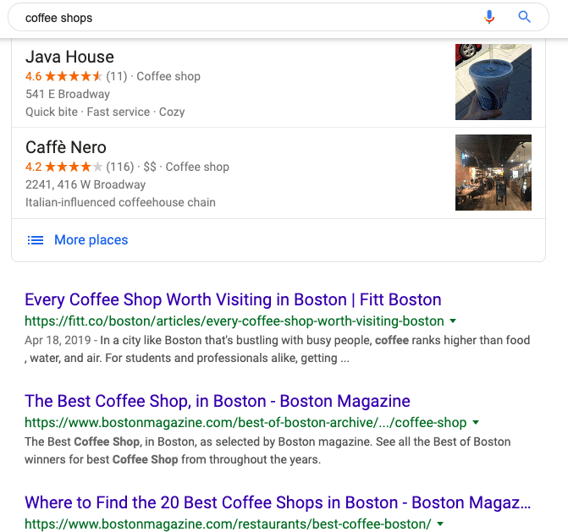Location-based marketing allows organizations to target consumers at a granular, person level with online or offline messaging based on their physical location. Using location data, marketing teams are able to reach consumers based on qualifiers like proximity to a store, events happening in their region, and more.
Location-based marketing has proven effective across customer lifecycles – from discovery and purchase, to engagement and retention. When used properly, location-based marketing allows marketers to hone in on specific customer segments with targeted offers, while improving customer experience for a population that increasingly values instant gratification. For example, location-based marketing may alert a prospect that a product they have been considering is stocked in a nearby store, allowing them to pick it up right away.
Types of Location-Based Marketing
Location-based marketing has largely been enabled over the past several years by the growth of connected devices. Today it seems that everything is connected to the internet - phones, cars, watches, and more. These devices are often tracking their owner’s location, meaning there is an abundance of location and spatial data available. Insights derived from this data provide marketing teams with greater context into how to reach customers and improve their overall experience.
There are several different ways marketers can channel this location data into their marketing efforts:
Geotargeting
Geotargeting is used to determine the location of a user, to then serve them personalized messaging based on their location. If a consumer has opted in to let an app access their location, they may get messages in the app or push notifications based on region or proximity to a store.
-
How it works
- Geotargeting is based off IP addresses. Every connected device has a unique IP address making them identifiable. From there, device IP addresses can be matched to country, zip code, etc. to determine where users are located.
-
Benefits
- The key benefit of geotargeting is to increase customer experience through personalization. For example, marketers can target users based on needs specific to their location, such as weather or local news and events.
-
Examples
-
- A popular example of geotargeting is Google search results. If a user searches “coffee shops,” Google will use location data based on the IP address of the device the search is conducted from to return information on coffee shops in the area.
-

Localized results for a search conducted in Boston
- Another common example of geotargeting is done by Uber. When a user is traveling and touches down in a new city, upon opening the app they will get a notification about available cars in that city.
Geofencing
Geofencing is the creation of a boundary within a specific region. When target audiences enter that boundary, they will become an active target of the marketing strategy. This might mean they receive content, offers, or some other form of messaging from the brand. An example of a boundary is an area that encompasses a popular shopping center at which the company has a store.
-
How it works
- Geofencing utilizes GPS technology to create a border. Whenever a target user crosses this border, they receive a notification or piece of messaging.
-
Benefits
-
Geofencing allows marketers to cover large areas, such as malls or event spaces. With this method, marketers can target all users that are within a certain perimeter. While less granular than other tactics, geofencing can be a great tool if you have a large convention or if you want to capture traffic right in front of your store.
-
-
- Geofencing is based on real-time location data, which allows marketers to encourage users to engage with their products, or divert consumers from engaging with competitors.
-
Examples
-
-
Retailers can use geofencing to target users near their stores to encourage them to stop into a shop. For example, if a customer has been reviewing a product online, they may get a notification that the product is in stock at a nearby store.
-
Beaconing
Beacons are connected devices that use Bluetooth or WIFI to connect with predetermined applications that are operating within range of the beacon. Beacons work well to target existing customers within a small geographic area.
-
How it works
- Beacons send a signal to your device that prompt a server to send content to your device. This could be a push notification, email, etc. For example, say a sports stadium encourages attendees to download their app for ticketing, concessions, etc. The venue would set up beacons to recognize when a device with that application installed is in range.
-
Benefits
- Users have to be opted-in and have Bluetooth on in order for you to take advantage of this. However, this medium of location-based targeting does give you a more direct communication channel with customers.
- Organizations can track users indoors in a more precise manner. This not only allows for more specific targeting, but helps marketers get a more complete understanding of customer behavior.
- Users don’t need to be online in order to receive these notifications.
-
Examples
- Stores can place beacons in aisles around the store to send offers as consumers browse. For example, a grocery store may use beacons to see when a consumer is in the ice cream aisle, and then send them a deal on ice cream cones.

Mobile Targeting
Mobile targeting occurs when marketers target consumers with ads on their mobile devices. Because consumers typically want to avoid advertising, marketers aim to make their ads context specific, which can be based on time, device, or location.
-
How it works
-
- Create segments in your mobile ad platform that define who you want to target and what qualifications to target them by (when they enter a certain area, or are in proximity of your store).
-
Benefits
-
-
- This allows marketers to target users directly on their devices for a more personalized connection.
- Marketers often see greater returns on ad spend using a more targeted approach.
-
-
-
Examples
-
- Social media ads that target based on location data can help encourage visits to a store, restaurant, or event nearby.
Geo-Conquesting
Geo-conquesting uses location data to divert prospects away from competitor locations. For example, car dealerships might create a boundary around a competitor’s lot. When a target consumer comes within that boundary, they will be sent an offer to users that encourages them to visit the other dealer.
-
How it works
- Geo-conquesting uses GPS technology to target users in the proximity of your competition.
-
Benefits
-
-
- Organizations can win market share and new customers by encouraging users they know are already shopping for a product in the space to purchase from them over a competitor.
-
-
Examples
-
- Burger King used geo-conquesting to great effect, diverting would-be McDonalds customers back to their own restaurants. Consumers were encouraged to download the Burger King app. When they came within 600 feet of McDonalds, the Burger King app sent a promotion for a 1 cent whopper, and navigated customers to the nearest location.
-
Reasons to Use Location-Based Marketing
Location-based marketing can offer a host of benefits to both consumers and marketers.
Marketers can deliver more targeted messaging that grows awareness and nurtures relationships with customers and prospects. The targeted-nature of these ads also often result in less wasted spend. Consumers, growing increasingly particular about which branded messaging they interact with, get personalized offers at convenient times, thus improving their overall experience.

A few of the key reasons marketers are using location-based tactics are:
-
Increase Immediate Foot Traffic
- Location-based marketing can drive foot traffic for local businesses such as retail stores or food service, by informing users in their market of proximity and enticing them with an offer.
-
Deliver more relevant ads
- Marketers can use real-time location data to create more relevant, personalized ads.This is not necessarily restricted to where a person is physically. Location data can also inform timing and messaging. For example, analysis may show that a consumer is more likely to engage with an ad when they are on the train or commuting, helping marketers determine when to serve an ad. Location data may also inform copy and creative. For example, marketing teams may choose to use images of the city the target consumer lives in, rather than generic imagery. Context and relevance have become crucial components of messaging that is engaged with, rather than ignored. Using these real-time insights ensures these criteria are met.
-
Drive consumers away from the competition
- By targeting users heading to a competitor’s business, marketers can encourage customers to visit their store instead, winning market share.
-
Create a Better User Experience
- By targeting customers when they are likely to need your services most, you can provide them with a better user experience.
For successful location-based marketing, it is important that marketers consider their location in addition to the location of their customers. For example, businesses located on a street with minimal foot traffic may not want to invest in location tactics. Similarly, stores that are not on street level, such as in apartment buildings or hotels, should be careful to only target people who are visiting the building to shop. For those not interested in visiting the store, regular alerts may cause annoyance and damage brand reputation.
As with all marketing investments, evaluate your customer base and impactful external factors to understand how these tactics will affect ROI, before committing ad spend.
Trends in Location Based Marketing
Marketers have begun to go beyond the common expectations of location-based marketing by harnessing these trends.
Augmented Location
Augmented location allows brands to do more with location data than just send notifications. Marketers can create experiences based on where the user is at the moment.
For example, think of Pokémon Go. This app tracks a user’s location, and using the camera function of their mobile device, places a digital creature within the user’s physical space.
Brands like Yelp are also playing into this trend, allowing users to point their camera at their current surroundings and see listings for nearby restaurants.
More Investment
Another trend in location-based marketing is its increased use. Retailers across the country are looking to invest in location-based marketing, with nearly 60 percent of retailers saying they would focus budget here in 2019. This said, as marketers adopt location-based tactics they are careful to consider user privacy.
Beacon Technology / Proximity Marketing
As noted, beacon technology uses Bluetooth to share information with user phones. As beacons become more advanced, marketers are leveraging them in location-based efforts more – specifically proximity marketing. Proximity marketing uses beacons to deliver highly-targeted messages to users within a very small range.
Prominent developments in beacon technology come from Apple, with the iBeacon, and Google with Eddystone-EID and Project Beacon.
Hyperlocal Marketing
Hyperlocal marketing tactics leverage location data and time-sensitive insights to engage customers. Marketers are able to focus on a smaller number of consumers in a certain town, or even on a certain block. This makes campaigns more personalized and easier to measure. Additionally, with personalization playing such an important role in marketing today, hyperlocal campaigns are easier to customize to niche audiences than large, national campaigns.
Before methods of mass commutations, hyperlocal marketing was a staple. The reach of the internet and television meant that marketers could spread messages further than their immediate proximity. Marketing teams are reverting back to this strategy, while incorporating new digital advances.
Privacy Concerns in Location Based Marketing

If you’re worried about user privacy when implementing location-based marketing, you are not alone. Privacy is a big concern for businesses who want to make the best use of location based marketing, with 59 percent of companies saying that these concerns are preventing them from moving forward with these types of applications.
There is a fine line between using location data to improve customer experience and appearing encroaching to customers. Beyond private information being shared with your organization and employees, customers are also wary of cyberattacks that could make their data available to broader, likely malicious audiences. These attacks harm both customers and businesses, as 64 percent of consumers say they would not shop at a business from which their data had been stolen.
To minimize these concerns, marketers must ensure that users opt into location sharing services when using apps, and have the ability to opt out. Anonymizing data can also help reduce privacy concerns, as information on behavior and preferences are not attached to specific names or email addresses. Finally, organizations must make sure cybersecurity solutions and protocols are put in place to reduce the chances of a successful attack.
Beyond consumer concerns, many regulating bodies have taken notice of personalization tactics through data collection, and have issued rules to ensure companies do not abuse consumer data.
GDPR
One of the most stringent regulations is GDPR, and is applicable to all organizations that do business with residents of the European Union. GDPR does not let companies target users without explicit opt-in, and has strict guidelines regarding the use and storage of EU citizen data. Consult with your legal team to get a better understanding what can be pursued via your company’s marketing efforts
Organizations must be compliant with local privacy laws before rolling out a location-based marketing program.
Beyond Privacy Concerns
When privacy and data collection / protection are handled in an appropriate, secure way, many consumers are willing to share information for a better customer experience. Consider these stats:
- Almost 100 percent of consumers would share their data for cash rewards
- Nearly 90 percent would share this data for discounts based on location
- 66 percent would share data for loyalty points / programs
If your company is able to provide a better experience to users, this can be a great tactic to strengthen relationships with customers and prospects by providing more relevant information and rewarding loyal customers.
Getting Started with Location-Based Marketing
To ensure your location-based efforts are successful and do not negatively impact your marketing ROI, consider the following before getting started:
- Clear up privacy concerns with your legal team: This should be the first step. Work with your legal team to understand who you can target and if the tactics you plan on using are compliant with local laws.
- Establish goals: The only way to measure impact is to have established clear goals and KPIs for what success looks like. What is the goal of the campaign? Are you trying to send alerts to people in your store or steer people away from a competitor?
- Choose a targeting method: Based on the goals established, choose a targeting method such as geofencing, geo-conquesting, or beaconing (see the first section of this post.) This targeting method should match your goal. For example: geotargeting could be a great way to drive former customers into your store, while geofencing may be a good way to attract new business for a restaurant during lunch hours.
- Analyze Results: Look at the data collected and determine which tactics worked well for your business and which didn’t. Use geo-zone analytics combined with marketing attribution analytics to get a better understanding of what drove conversions.
Examples of Brands Using Location Based Marketing
- Adidas: Adidas used location extensions in their search ads to encourage visitors to shop at the closest store. One out of every five people who viewed the page ended up going to a physical store, leading to a 680% increase in ROI.
- Whole Foods: Whole Foods used both geofencing and geo-conquesting tactics to win market share and increase conversions. The supermarket targeted buyers at nearby grocery stores with special discounts, encouraging them to visit Whole Foods stores instead. Similarly, shoppers already planning on going to Whole Foods or passing by received special offers – creating better experiences for existing customers and attracting new customers in the area. This campaign had a 4.69 percent conversion rate (the national average is 1.43 percent)
Combining Location Data with Other Data Points
Location data is valuable to better understand customer behavior and issue more personalized offerings at the right time. However, it is still only one data point. To create the best customer experiences, marketing teams must combine location data with additional insights for a complete picture of needs and preferences.
Location data should be compared with attribution models such as unified marketing measurement (UMM) to get a better understanding of the customer. Centralizing data in this way will not only illuminate marketing tactics based on real-time location, but creative preferences, the type of device the consumer users, when they shop, and historical date on what they have purchased.
Be sure that location efforts are not siloed from the rest of your marketing strategy, but rather are used to inform broader strategies to create a more cohesive view of your customers.



